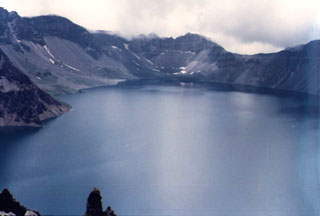Report on Changbaishan (China-North Korea) — October 1994
Bulletin of the Global Volcanism Network, vol. 19, no. 10 (October 1994)
Managing Editor: Richard Wunderman.
Changbaishan (China-North Korea) Possible gas emissions from summit and hot springs
Please cite this report as:
Global Volcanism Program, 1994. Report on Changbaishan (China-North Korea) (Wunderman, R., ed.). Bulletin of the Global Volcanism Network, 19:10. Smithsonian Institution. https://doi.org/10.5479/si.GVP.BGVN199410-305060
Changbaishan
China-North Korea
41.98°N, 128.08°E; summit elev. 2744 m
All times are local (unless otherwise noted)
A news report on 3 November noted that gas emissions from the summit are frequent, many minor volcanic earthquakes have been felt during the last two years, and nearby hot springs were also emitting volcanic gases. The official Xinhua News Agency quoted Ruoxin Liu from the State Seismological Bureau, but we have received no direct confirmation.
Charles Dunlap, Susanne Horn, and Hans Schmincke worked on and around the summit with Chinese geologist Tang Deping during 21-25 July 1993, but saw no emissions. One hot spring area was observed by Dunlap in the N-flank valley, which begins at the lake outlet into the Erdobaihe River. These springs were next to the trail to the waterfall and on up to the lake's edge; eggs were boiled in the spring water for sale to tourists. A weak sulfur smell was detected, but it was not as pronounced as at some springs in Yellowstone or Long Valley (USA). No other emissions were noticed from these springs. Another hot spring location W of this valley was not visited, but apparently it is popular as a bath. On the E border of the crater lake (Korean side), water from a hot spring with a temperature of 700°C was being pumped to the crater rim to provide healing potions.
Baitoushan (Korean name P'aektu-san) is a large stratovolcano on the Korea-Manchurian border ~300 km SE of Changchun and 325 km WSW of Vladivostok, Russia. The 60-km-diameter volcano was constructed over the Changbaishan (Laoheidingz) shield volcano and has a 5-km-wide summit caldera. One of the world's largest known Holocene explosive eruptions took place around 1000 A.D., depositing tephra as far away as N Japan and forming in part the 850-m-deep depression filled by Tianchi Lake. The much better exposed pyroclastic deposits on the North Korean side studied by Horn and Schmincke are extremely thick and include major ignimbrites. Four historical eruptions have been recorded since the 15th century (1413, 1597, 1668, and 1702). Chinese geologists spoken to by Dunlap thought that these historical events were probably phreatic explosions, and that there have possibly been occasional gas emissions within approximately the last 50 years.
Geological Summary. Massive Changbaishan stratovolcano (also known as Baitoushan and by the Korean names of Baegdu, Paektu, or P'aektu-san), is located along the China/Korea border. A 5-km-wide, 850-m-deep summit caldera is filled by Lake Tianchi (Sky Lake). The 60-km-diameter dominantly trachytic and rhyolitic volcano was constructed over the Changbaishan (Laoheidingzi) shield volcano. Satellitic cinder cones are aligned along a NNE trend. One of the largest known Holocene explosive eruptions took place here about 946 CE, depositing tephra as far away as northern Japan and forming in part the present caldera; Yang et al. (2021) estimated the total erupted volume to be 40-98 km3. Minor eruptions have been recorded since the 15th century.
Information Contacts: C. Dunlap, University of California - Santa Cruz; S. Horn and H. Schmincke, GEOMAR; Xinhua News Agency, China; UPI.

